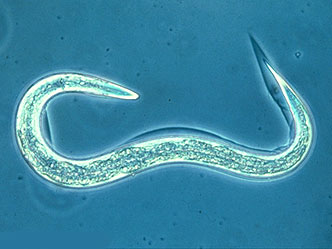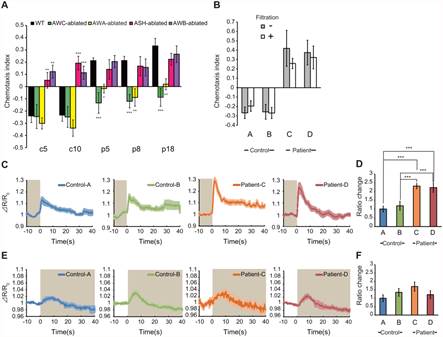线虫或是“验癌高手”
来源:PLOS ONE
作者:Takaaki Hirotsu
时间:2015-03-23


别看线虫体长仅1毫米左右,日本科研人员最新发现,它在识别癌症方面有“特长”。线虫可根据气味准确辨识出癌症患者的尿液,未来有望据此开发出简单而廉价的诊断方法。
此前研究已知,癌症患者的尿液及呼出气体有特殊气味,因此有人研究利用癌症嗅探犬来诊断癌症。不过,训练一条合格的嗅探犬并不容易,且成本不菲。
日本九州大学等机构研究人员在美国新一期《公共科学图书馆综合卷》上报告说,他们采集了218名健康人和24名癌症患者的尿液,将尿液样本置于玻璃皿上,然后将50至100条“秀丽隐杆线虫”放在玻璃皿中央,观察其反应。这种线虫拥有和狗相当的嗅觉受体。
结果发现,线虫普遍远离健康人的尿液,而聚集到癌症患者的尿液旁,准确率高达95%左右。研究人员通过基因操作,使线虫的部分嗅觉功能失灵,结果发现它们不再有此表现。这说明线虫“偏好”的是癌症患者尿液的气味。
此次研究涉及胃癌、食道癌、前列腺癌、胰腺癌等多种癌症,且有些癌症处于很早期阶段,而线虫不分癌症种类和发展程度,都能准确识别出癌症患者的尿液。
研究人员说,线虫与狗的嗅觉能力相当,且更容易饲养,如果能将本次研究成果推向实用,有望大幅降低癌症检查费用,并使检查过程更加便捷,约一个半小时就能得出结果。
A Highly Accurate Inclusive Cancer Screening Test Using Caenorhabditis elegans Scent Detection
Abstract Early detection and treatment are of vital importance to the successful eradication of various cancers, and development of economical and non-invasive novel cancer screening systems is critical. Previous reports using canine scent detection demonstrated the existence of cancer-specific odours. However, it is difficult to introduce canine scent recognition into clinical practice because of the need to maintain accuracy. In this study, we developed a Nematode Scent Detection Test (NSDT) using Caenorhabditis elegans to provide a novel highly accurate cancer detection system that is economical, painless, rapid and convenient. We demonstrated wild-type C. elegans displayed attractive chemotaxis towards human cancer cell secretions, cancer tissues and urine from cancer patients but avoided control urine; in parallel, the response of the olfactory neurons of C. elegans to the urine from cancer patients was significantly stronger than to control urine. In contrast, G protein α mutants and olfactory neurons-ablated animals were not attracted to cancer patient urine, suggesting that C. elegans senses odours in urine. We tested 242 samples to measure the performance of the NSDT, and found the sensitivity was 95.8%; this is markedly higher than that of other existing tumour markers. Furthermore, the specificity was 95.0%. Importantly, this test was able to diagnose various cancer types tested at the early stage (stage 0 or 1). To conclude, C. elegans scent-based analyses might provide a new strategy to detect and study disease-associated scents.
原文链接:http://journals.plos.org/plosone/article?id=10.1371/journal.pone.0118699




